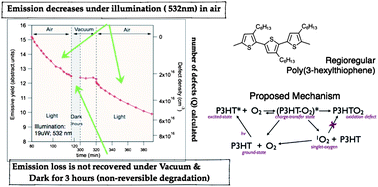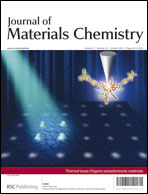Matter of minutes degradation of poly(3-hexylthiophene) under illumination in air†
Abstract
Films of regioregular poly(3-hexylthiophene) [P3HT] were monitored for degradation by means of in situ fluorescence quenching measurements. The films were found to be stable under UV or VIS energy illumination in vacuo and stable to the air when kept in the dark. Under illumination in air however, degradation products were formed immediately as seen by the fluorescence quenching. The quantum yield for defect product formation was calculated to be around 3 × 10−6 per incident

- This article is part of the themed collection: Organic optoelectronic materials

 Please wait while we load your content...
Please wait while we load your content...